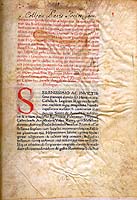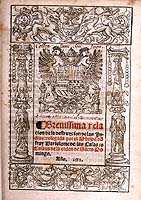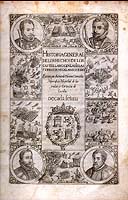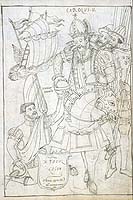|

title-page of
Arévalo Compendiosa historia
Hispanica
(Hunterian Bw.2.19) |
Rodrigo Sánchez de Arévalo Compendiosa historia
Hispanica
Rome: Ulrich Han [not after 4 Oct. 1470]
Hunterian Bw.2.19
This is a copy of the first edition of the first
history of Spain to be printed. The work begins with a geographical
description of the country, including a chapter on its mineral resources,
then proceeds to the history from the Visigothic invasion (414 A.D.) to
the early years of the reign of King Enrique IV of Castile and Leon
(1469), to whom the work is dedicated.
Rodrigo Sánchez de Arévalo (1404-1470) became a
noted Papal diplomat, and was successively Bishop of Zamora, Calahorra,
and Palencia.
|
|

title-page of Las Casas
Brevissima relacion de la
destruycion de las Indias
(Hunterian K.6.11) |
Bartolomeo de Las Casas Brevissima relacion de la
destruycion de las Indias
Seville: Sebastian Trugillo, 1552
Hunterian K.6.11
Bartolemeo de Las Casas, the 'Apostle of the Indies',
was born in Seville, but went at the age of 28 to Hispaniola, settled
there, and was ordained. In 1511 he went as curate to a village in Cuba.
He soon began to preach against the atrocious wrongs committed by the
Spaniards against the natives, arguing that the Indian is by nature
virtuous and peacable, but has been corrupted by an alien civilization.
Las Casas made numerous voyages between the Indies and
Spain, in his endeavours to alleviate the condition of the
indigenous peoples. At last wearied with his efforts and lack of success
he retired to a Dominican convent in San Domingo in 1522, where he spent
eight years.in retirement, occupied in study and writing. In 1539, while
in Spain, he wrote his Destruycion de las Indias, one of the
most gruesome books ever written.
|
|

title-page of Herrera y Tordesillas Historia general ...
(Hunterian Bs.2.7) |
Antonio de Herrera y Tordesillas Historia general de
los hechos de los Castellanos en las islas i tierra firme del Mar Oceano
Madrid: Imprenta Real, 1601-1615
Hunterian Bs.2.4-7
This is an indispensable source work for the early
history of America. Herrera's position as official chronicler of the
Indies gave him access to a large amount of manuscript material which is
no longer extant. The work begins with the history of the voyages of
Columbus and includes events in America up to 1554, with the suppression
of the revolt of Francisco Hernandez Giron in Peru.
On the title pages of the four volumes are the engraved
portraits of the most famous missionaries, generals, governors, and
soldiers who served in America during its conquest and occupation. The
fourteen engraved maps are in many cases the first of many of the American
provinces described.
|
|

folio 249r: Camargo Historia de Tlaxcala
(MS Hunter 242) |
Diego Muńoz Camargo Historia de Tlaxcala
Mexico: 1585
MS Hunter 242 (U.3.15)
The Tlaxcaltecas were the fiercest enemies of the
Aztecs, and subsequently became loyal allies of the Spanish. When
Cortés arrived in Tlaxcala in 1519 he found its inhabitants confined
to a small territory, vigorously defending their independence from
their powerful neighbours. The codex in addition to being a major
source for Tlaxcaltecan history, topography and social conditions,
is clearly intended to celebrate the Tlaxcaltecas' role in the
conquest of the New World.
Two methods of computing time are described, each
illustrated with a calendrical wheel. The pictorial section, the
work of an unknown, indigenous artist, comprises 157 pen and ink
drawings with short Nahuatl captions written above the picture;
these are glossed in Spanish by a different hand below. Some eighty
are almost identical to those found in the Lienzo de Tlaxcala,
which may have been a source for the Hunterian series.
The early pictures depict the first encounters
between the Spanish and the Tlaxcaltecans; the conversion of the
population to Christianity, the destruction of cultic objects and
native books, and the punishment of those not conforming to the new
order. Also shown are the nine provinces which were subjugated to
Spanish rule, with their emblems and episcopal mitres. The remainder
of the images include impressive, equestrian portraits of Cortés,
Columbus, Pizarro, Charles V, and Philip II, and spirited evocations
of the many victories and conquests of the allied forces.
Muńoz Camargo travelled to Spain in 1584 in the
company of other Tlaxcaltecans as part of a diplomatic mission. The
manuscript, which was completed and bound in Madrid, was presented
to the king in 1585. It remained in the Biblioteca Real at least
until the early seventeenth century, after which its fate is obscure
until acquired by Dr William Hunter (1718-83) for his famous museum,
established in 1768, in Windmill Street.
For more information (and further images) about
this book, see the January 2003 book
of the month article
|
|